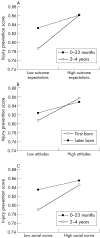Differential strength of association of child injury prevention attitudes and beliefs on practices: a case for audience segmentation
- PMID: 16461418
- PMCID: PMC2563488
- DOI: 10.1136/ip.2004.007153
Differential strength of association of child injury prevention attitudes and beliefs on practices: a case for audience segmentation
Abstract
Objective: Many injuries to children cannot be prevented without some degree of active behavior on the part of parents. A better understanding of social and cognitive determinants of parents' injury prevention behavior and the identification of potential subgroups for targeted message delivery could advance the effectiveness of educational and behavioral interventions. This study assessed the degree to which parents' injury prevention behavior is associated with theoretical determinants and examined whether this relation differs by age or birth order of child.
Design: Cross sectional observational study.
Setting: Three Midwestern pediatric clinics.
Subjects: 594 parents of children ages 0-4 attending routine well child visits.
Measures: Injury prevention attitudes, beliefs, and practices.
Results: Overall, only modest relations were observed between injury beliefs and attitudes and injury prevention behaviors. However, these relations differed substantially by child age and birth order, with stronger associations observed for parents of older first born children. Outcome expectations and social norms were more strongly related to injury prevention behavior among parents of preschool children than among parents of infants and toddlers, while attitudes were more predictive for parents of first born children than parents of later born children.
Conclusions: These findings highlight the complexity of relations between theorized determinants and behavior, and suggest the potential utility of using audience segmentation strategies in behavioral interventions addressing injury prevention.
Conflict of interest statement
Competing interests: none.
Similar articles
-
Parents' attitudes as mediators between knowledge and behaviours in unintentional injuries at home of children aged 0-3 in Shanghai, Eastern China: a cross-sectional study.BMJ Open. 2021 Dec 23;11(12):e054228. doi: 10.1136/bmjopen-2021-054228. BMJ Open. 2021. PMID: 34949628 Free PMC article.
-
Classification of unintentional injury prevention practices for infants and young children at home: developmental process and associations with other variables in Japanese families.BMC Psychol. 2025 Apr 25;13(1):441. doi: 10.1186/s40359-025-02770-5. BMC Psychol. 2025. PMID: 40275363 Free PMC article.
-
Parental beliefs regarding developmental benefits of childhood injuries.Am J Health Behav. 2004;28 Suppl 1:S61-8. doi: 10.5993/ajhb.28.s1.7. Am J Health Behav. 2004. PMID: 15055572
-
American Parents' Attitudes and Beliefs About Corporal Punishment: An Integrative Literature Review.J Pediatr Health Care. 2017 May-Jun;31(3):372-383. doi: 10.1016/j.pedhc.2017.01.002. Epub 2017 Feb 13. J Pediatr Health Care. 2017. PMID: 28202205 Review.
-
Child, Caregiver, Family, and Social-Contextual Factors to Consider when Implementing Parent-Focused Child Feeding Interventions.Curr Nutr Rep. 2018 Dec;7(4):303-309. doi: 10.1007/s13668-018-0255-9. Curr Nutr Rep. 2018. PMID: 30353367 Free PMC article. Review.
Cited by
-
Understanding Parental Adherence to Early Childhood Domestic Injury Prevention: A Cross-Cultural Test of the Integrated Behavior-Change Model.Behav Sci (Basel). 2024 Aug 12;14(8):701. doi: 10.3390/bs14080701. Behav Sci (Basel). 2024. PMID: 39199097 Free PMC article.
-
Development of targeted messages to promote smoking cessation among construction trade workers.Health Educ Res. 2015 Feb;30(1):107-20. doi: 10.1093/her/cyu050. Epub 2014 Sep 16. Health Educ Res. 2015. PMID: 25231165 Free PMC article.
-
Conceptual and measurement issues in early parenting practices research: an epidemiologic perspective.Matern Child Health J. 2010 Nov;14(6):958-70. doi: 10.1007/s10995-009-0532-8. Matern Child Health J. 2010. PMID: 19866348
-
Unintentional Home Injury Prevention in Preschool Children; a Study of Contributing Factors.Emerg (Tehran). 2016 Spring;4(2):72-7. Emerg (Tehran). 2016. PMID: 27274516 Free PMC article.
-
Critical environmental factors for transportation cycling in children: a qualitative study using bike-along interviews.PLoS One. 2014 Sep 24;9(9):e106696. doi: 10.1371/journal.pone.0106696. eCollection 2014. PLoS One. 2014. PMID: 25250738 Free PMC article.
References
-
- Slater M D. Theory and method in health audience segmentation. J Health Commun 19961267–283. - PubMed
-
- Slater M. Choosing audience segmentation strategies and methods for health communication. In: Maibach E, Parrott R, eds. Designing health messages: approaches from communication theory and public health practice. Thousand Oaks, CA: Sage Publications, 1995186–198.
-
- Kreuter M W, Wray R J. Tailored and targeted health communication: strategies for enhancing information relevance. Am J Health Behav 200327(Suppl 3)S227–S232. - PubMed
-
- Centers for Disease Control and Prevention Web‐based Injury Statistics Query and Reporting System. Atlanta, Georgia, National Center for Injury Prevention and Control, 2002
-
- Centers for Disease Control and Prevention Childhood Injury Fact Sheet. 2004. Atlanta, Georgia, National Center for Injury Prevention and Control
Publication types
MeSH terms
Grants and funding
LinkOut - more resources
Full Text Sources
Medical

